
Banksia purdieana is a species of bushy shrub that is endemic to Western Australia. It has broadly linear, pinnatipartite leaves with sharply-pointed lobes on the sides, yellow flowers in heads of about eighty and egg-shaped follicles.

Grevillea excelsior, commonly known as flame grevillea or yellow flame grevillea, is a species of flowering plant in the family Proteaceae and is endemic to the south-west of Western Australia. It is an erect shrub or small tree with usually divided leaves with linear lobes, and clusters of orange flowers.

Grevillea asteriscosa, commonly known as star-leaf grevillea, is a species of flowering plant in the family Proteaceae and is endemic to the south-west of Western Australia. It is a shrub with widely-spreading branches, star-shaped leaves with sharply-pointed lobes, and bright red flowers.

Melaleuca cliffortioides is a plant in the myrtle family, Myrtaceae and is endemic to the south-west of Western Australia. It is a small, prickly shrub very similar to Melaleuca podiocarpa but with fewer stamens in the flowers.
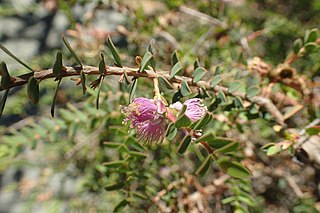
Melaleuca platycalyx is a plant in the myrtle family, Myrtaceae, and is endemic to the south-west of Western Australia. It is a small, twiggy shrub with short spikes of purple or pink flowers in spring. The distinguishing features of this species include petals that are bent downwards, an unusually large number of stamens in each flower and unusually large fruits arranged in alternating pairs.
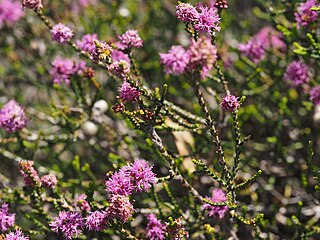
Regelia cymbifolia is a plant in the myrtle family, Myrtaceae and is endemic to the south-west of Western Australia. It is a much branched shrub bearing tiny, wedge shaped leaves and clusters of deep pink to purple flowers on the ends of its branches in spring.

Isopogon alcicornis, commonly known as the elkhorn coneflower, is a plant in the family Proteaceae and is endemic to part of the South Coast Western Australia. It is a low shrub with pinnately-lobed leaves and oval heads of hairy, white or pink flowers.

Eremophila chamaephila, commonly known as earth-loving poverty bush, is a flowering plant in the figwort family, Scrophulariaceae, and is endemic to the south-west of Western Australia. It is a low, dense, spreading shrub with small, fleshy leaves and mauve to purple flowers.

Eremophila georgei is a flowering plant in the figwort family, Scrophulariaceae and is endemic to Western Australia. It is a common, widespread shrub in central areas of the state, often growing on rocky ridges and hillsides and has serrated leaves and mauve, purple or pink flowers.

Eremophila ionantha is a flowering plant in the figwort family, Scrophulariaceae and is endemic to Western Australia. It is a shrub with many sticky branches, narrow, light green leaves and blue, purple or violet flowers.

Hakea polyanthema is a species of flowering plant in the family Proteacea that is endemic to Western Australia. It is a shrub with needle-shaped leaves and small groups of small unpleasantly scented flowers in leaf axils.
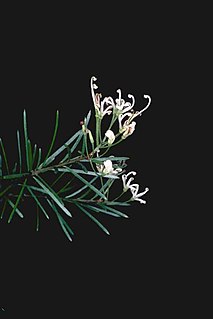
Grevillea inconspicua, commonly known as Cue grevillea, is a species of flowering plant in the family Proteaceae and is endemic to the central-west of Western Australia. It is a prickly, densely-branched shrub with linear leaves and clusters of off-white to silvery grey flowers.
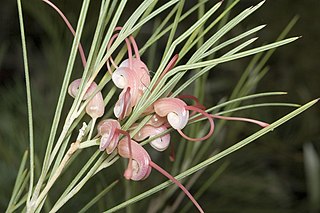
Grevillea oncogyne is a species of flowering plant in the family Proteaceae and is endemic to inland areas of Western Australia. It is an erect to spreading shrub with linear, sometimes lobed leaves, and clusters of red or pinkish red flowers.
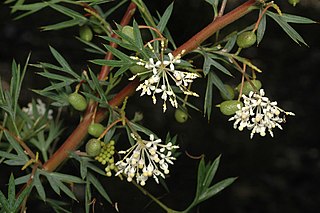
Grevillea phanerophlebia, commonly known as the prominent vein grevillea and the vein leaf grevillea, is a species of flowering plant in the family Proteaceae and is endemic to a restricted part of the south-west of Western Australia. It is an erect, spreading or straggly shrub with divided leaves, the lobes linear, and white and cream-coloured to yellow flowers.

Kunzea montana, commonly known as mountain kunzea, is a flowering plant in the myrtle family, Myrtaceae and is endemic to the south-west of Western Australia. It is a shrub or small tree with more or less round leaves and heads of cream-coloured to pale yellow flowers on the ends of the branches in late spring. It is an uncommon species, growing on rocky mountain slopes, but all populations are conserved in the Stirling Range National Park.
Conothamnus neglectus is a member of the family Myrtaceae endemic to Western Australia. This open shrub typically grows to a height of 0.2 to 1.0 metre. It blooms in between July and September producing yellow flowers.
Hakea recurva subsp. arida is a plant in the family Proteaceae endemic to the south-west of Western Australia.

Teucrium eremaeum is a species of flowering plant in the family Lamiaceae and is endemic to the south-west of Western Australia. It is a perennial herb or shrub with small, linear to lance-shaped leaves and white or cream-coloured flowers.
Teucrium myriocladum is a species of flowering plant in the family Lamiaceae and is endemic to the south-west of Western Australia. It is a shrub with small, hairy leaves and creamy-green flowers.
Lasiopetalum microcardium is a species of flowering plant in the family Malvaceae and is endemic to the south-west of Western Australia. It is a low, spreading or straggling shrub with hairy stems, heart-shaped leaves and blue, purple or white flowers.


















